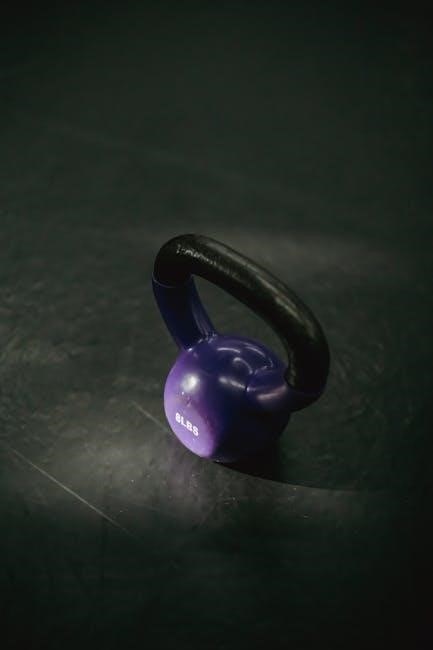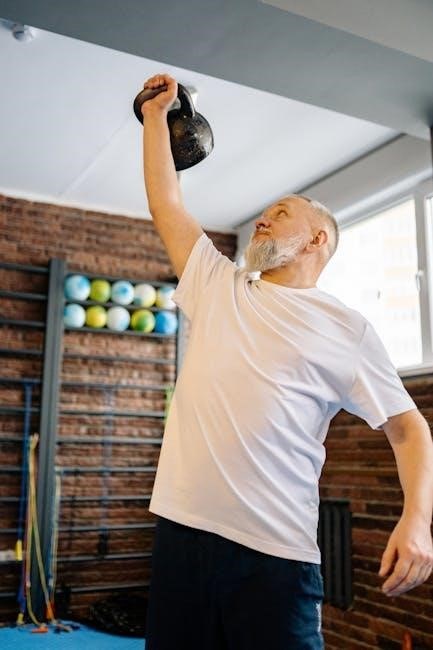Kettlebell workouts are versatile, effective, and combine strength training with cardio. They suit all fitness levels, making them a favorite among enthusiasts. Popular programs like Prometheus Protocol and KBOMG focus on muscle gain and efficiency, offering structured plans for consistent results.
What Are Kettlebell Workouts?
Kettlebell workouts are dynamic exercises using a weighted ball with a handle, combining strength training and cardio. They involve swings, presses, squats, and more, targeting full-body engagement. These workouts are versatile, suitable for all fitness levels, and require minimal equipment. Popular programs like the Prometheus Protocol and KBOMG focus on muscle gain and efficiency. Kettlebell exercises promote functional strength, mobility, and endurance, making them ideal for those seeking a time-efficient, effective training method. Whether for beginners or advanced athletes, kettlebell workouts offer a comprehensive way to improve overall fitness and achieve specific goals. Their adaptability ensures they remain a popular choice for home and gym training.
Why Kettlebell Workouts Are Popular
Kettlebell workouts are popular due to their efficiency and versatility. They combine strength training with cardio, offering a full-body workout in minimal time. The use of a single piece of equipment makes them accessible for home training, appealing to those with busy schedules. Programs like Prometheus Protocol and KBOMG provide structured plans for muscle gain, attracting fitness enthusiasts seeking results. Kettlebell exercises also improve functional strength and mobility, making them ideal for various fitness levels. Their adaptability and effectiveness have made them a favorite among both beginners and advanced athletes, ensuring their continued popularity in the fitness community. This accessibility and effectiveness drive their widespread adoption.
Benefits of Kettlebell Training
Kettlebell training offers numerous benefits, including improved strength, endurance, and mobility. It engages multiple muscle groups simultaneously, providing a full-body workout that enhances functional strength. The dynamic movements, such as swings and presses, boost cardiovascular fitness while increasing power and coordination. Kettlebells are also portable, making them ideal for home or travel workouts. Regular training can improve posture, reduce injury risk, and enhance overall athleticism. Additionally, kettlebell exercises are scalable, catering to all fitness levels, from beginners to advanced athletes. Their versatility and efficiency make them a popular choice for those seeking a well-rounded and time-effective training method. This makes kettlebell training a valuable addition to any fitness routine.


Getting Started with Kettlebell Workouts
Starting with kettlebells involves choosing the right weight, learning basic movements, and setting up a safe space. Begin with foundational exercises like swings and presses to build strength and coordination.
Choosing the Right Kettlebell
Selecting the right kettlebell is crucial for effective training. Start with a weight that allows 8-10 reps with good form. For beginners, 16-24 kg is ideal. Consider your fitness goals: lighter bells for cardio, heavier for strength. Ensure the handle is smooth and comfortable. If using two bells, choose matching weights for balance. Proper weight selection prevents injury and maximizes results. Always prioritize quality and durability to ensure safety during workouts.
Understanding Basic Kettlebell Movements
Mastering basic kettlebell movements is essential for effective and safe training. The kettlebell swing is a cornerstone, targeting the hips, glutes, and hamstrings. Proper form involves a hinge motion, explosive power, and controlled descent. The Turkish get-up builds strength and mobility, starting from a lying position to standing with the kettlebell overhead. Cleans and presses work the entire body, focusing on power and precision. Goblet squats and rows target specific muscle groups while improving stability. Each movement requires attention to form to prevent injury and maximize results. Start with lighter weights to perfect technique before progressing to heavier loads. Consistency and proper form are key to unlocking the full potential of kettlebell training.

Setting Up a Home Workout Space

Creating a dedicated home workout space is crucial for effective kettlebell training. Choose a flat, non-slip surface with enough room to swing and move freely. Ensure proper lighting to maintain visibility and safety. A full-length mirror can help monitor form and technique. Store kettlebells in an organized manner, ideally on a rack or mat to protect the floor. Consider investing in a pull-up bar or rings for complementary exercises. Keep the area clutter-free to avoid distractions and potential hazards. A well-prepared space enhances focus, safety, and overall training efficiency, making your kettlebell workouts more enjoyable and productive.
Designing a Kettlebell Workout Plan
A well-structured kettlebell workout plan balances strength, cardio, and mobility. Tailor routines to your fitness goals, incorporating variations and progressions for continuous growth and engagement.
Understanding Your Fitness Goals
Defining clear fitness goals is crucial for designing an effective kettlebell workout plan. Whether aiming for muscle gain, weight loss, or improved endurance, understanding your objectives helps tailor exercises and intensity. For instance, the Prometheus Protocol focuses on hypertrophy, using double clean and press exercises with 80% of your 1RM, done twice a week. This approach, combined with proper nutrition, has yielded significant results for many. Conversely, programs like KBOMG emphasize full-body engagement with single kettlebell workouts, ideal for those seeking overall strength and muscle balance. Clarity in goals ensures a focused and efficient training path.
Creating a Balanced Workout Routine
A balanced kettlebell routine combines strength, cardio, and mobility. Programs like Prometheus Protocol and KBOMG offer structured plans, focusing on exercises like clean and press, front squats, and rows. These workouts target major muscle groups, ensuring overall development. For example, Prometheus Protocol suggests 5×10 double clean and press, while KBOMG emphasizes single kettlebell exercises for full-body engagement. Incorporating variations like Turkish get-ups and swings adds diversity. Balancing intensity with recovery is key, as overtraining can hinder progress. Tracking workouts and adjusting weights or reps helps maintain balance and ensures long-term success. A well-rounded routine keeps training engaging and effective.
Incorporating Variations and Progressions
Variations and progressions in kettlebell training keep workouts engaging and prevent plateaus. Programs like Prometheus Protocol and KBOMG offer structured exercises, such as clean and press, front squats, and rows, which can be modified to suit different fitness levels. For example, adding pauses or changing grips can increase difficulty. Swings and Turkish get-ups are versatile movements that can be progressed by increasing weight or reps. Incorporating supersets or time-based challenges, as seen in 15-30 minute full-body workouts, adds intensity. Progressions ensure continuous improvement, whether focusing on muscle gain or endurance. Adjusting techniques and weights helps tailor workouts to individual goals, keeping training dynamic and effective.

Popular Kettlebell Workout Programs
Programs like Prometheus Protocol and KBOMG are designed for muscle gain, using exercises like clean and press, front squats, and rows. They emphasize progressive overload and consistency.
The Prometheus Protocol for Muscle Gain
The Prometheus Protocol is a structured program designed to build muscle and strength using kettlebells. It focuses on compound movements like the double clean and press, double front squat, and rows. The program recommends using 80% of your one-rep max for weights, ensuring progressive overload. Workouts are performed twice a week on non-consecutive days, allowing adequate recovery time. Emphasis is placed on consistency and proper nutrition to support muscle growth. Many users have reported significant gains in strength and size over a month. This protocol is ideal for those seeking a straightforward, effective approach to hypertrophy with kettlebells.
KBOMG: Kettlebell Only Muscle Gain Program
The KBOMG program is specifically designed for muscle gain using only kettlebells. It focuses on compound movements like swings, presses, and rows, targeting all major muscle groups. The program emphasizes progressive overload and consistency, with workouts structured to maximize hypertrophy. Many users have reported significant strength and muscle gains, making it a popular choice for those seeking an efficient, kettlebell-only approach. The program’s simplicity and effectiveness make it ideal for both beginners and advanced lifters looking to build muscle without complex equipment. Regular updates and variations ensure continued progress and engagement.
Single Kettlebell Workouts for Full-Body Training
Single kettlebell workouts are ideal for full-body training, offering convenience and efficiency. They target multiple muscle groups simultaneously, improving strength and cardiovascular fitness. Exercises like swings, cleans, and presses engage the entire body, while movements such as goblet squats and Turkish get-ups focus on functional strength. These workouts are perfect for those with limited space or equipment, as they require only one kettlebell. The versatility of single kettlebell routines allows for varied and challenging sessions, making them suitable for all fitness levels. Many users appreciate the simplicity and effectiveness of these workouts, which can be adapted to meet individual goals and progress.
Advanced Kettlebell Techniques
Mastering advanced kettlebell techniques enhances strength and skill. Movements like the Turkish get-up and kettlebell swing require precision and control, targeting multiple muscle groups for functional fitness.
Mastering the Turkish Get-Up

The Turkish Get-Up is a foundational kettlebell exercise that combines strength, mobility, and coordination. It involves transitioning from a lying to a standing position while holding the kettlebell overhead. This movement engages multiple muscle groups, including the core, shoulders, and legs, making it a full-body workout. Proper form is crucial to avoid injury, with a focus on controlled transitions and maintaining a straight line from the kettlebell to the heel. Incorporating the Turkish Get-Up into routines like the Prometheus Protocol or KBOMG can enhance muscle gain and overall functional fitness. Consistent practice and attention to detail are key to mastering this exercise.
Perfecting the Kettlebell Swing
The kettlebell swing is a cornerstone of kettlebell training, offering a powerful way to build strength, endurance, and coordination. It involves a dynamic hip hinge movement, generating power from the lower body while maintaining a tight grip and controlled form. Proper technique is essential, with focus on explosive hip drive and avoiding excessive back strain. The swing is a key component in programs like the Prometheus Protocol and KBOMG, often performed in high sets to maximize muscle engagement. Consistency and attention to form are critical for mastering this exercise and reaping its full benefits. Regular practice ensures improved power and overall physical fitness.
Advanced Pressing and Pulling Techniques

Advanced pressing and pulling techniques with kettlebells are designed to challenge even experienced lifters. These movements, such as double clean and press or weighted pull-ups, target the upper body while engaging the core for stability. Programs like the Prometheus Protocol emphasize these exercises to build strength and muscle. Proper form is crucial to avoid injury, with a focus on explosive power and controlled movements. Incorporating variations, such as single-arm presses or pull-ups with a kettlebell, adds complexity and targets specific muscle groups. Consistent practice and progressive overload are key to mastering these techniques and achieving significant gains in strength and endurance.

Safety and Recovery
Proper warm-ups and cool-downs are essential for preventing injuries. Focus on dynamic stretches and controlled movements to prepare muscles and joints for kettlebell training.
Warm-Up and Cool-Down Routines
A proper warm-up is crucial before kettlebell training to prevent injuries and prepare muscles. Start with dynamic stretches like arm circles, leg swings, and torso twists. Incorporate light cardio such as jumping jacks or jogging in place for 5-10 minutes. Transition into kettlebell-specific movements like gentle swings and halos to activate the shoulders and hips. After your workout, cool down with static stretches focusing on the hamstrings, shoulders, and lower back. Deep breathing exercises can also aid in recovery. Hydration and foam rolling are additional recovery tools to reduce muscle soreness and improve flexibility. Consistency in these routines enhances overall training efficiency and longevity.
Preventing Injuries with Proper Form
Proper form is essential to prevent injuries during kettlebell workouts. Common mistakes include rounding the back during swings or using momentum over control. Maintain a neutral spine, engage your core, and hinge at the hips. For exercises like cleans and presses, ensure the kettlebell path is tight to the body to avoid shoulder strain. Start with lighter weights to master techniques before increasing load. Pay attention to grip and body positioning to distribute force evenly. Poor form can lead to muscle strains or long-term issues like back pain. Prioritize technique over reps to ensure safe and effective training. Consistency in proper form enhances both safety and results.
Recovery Techniques for Kettlebell Training
Recovery is crucial for optimizing kettlebell training results. Incorporate techniques like foam rolling and stretching to relieve muscle tension. Post-workout, focus on dynamic stretches for major muscle groups. Use tools like massage guns or rollers to target areas worked, such as shoulders and legs. Ensure adequate sleep and nutrition, prioritizing protein intake to aid muscle repair. Active recovery, such as light cardio or yoga, can enhance blood flow without overexertion. Additionally, consider ice baths or contrast showers to reduce inflammation. Proper recovery prevents overtraining and supports long-term progress, ensuring you can maintain intensity in future workouts. Consistency in recovery routines is key to sustained performance and injury prevention.

Tracking Progress and Staying Motivated
Track your kettlebell workouts by logging reps, weights, and sets. Celebrate milestones to stay motivated and visualize improvements. Regular progress checks keep you driven and focused.
Setting and Achieving Fitness Milestones
Setting clear fitness milestones is crucial for success in kettlebell training. Start by identifying specific, measurable goals, such as increasing your kettlebell swing reps or mastering the Turkish get-up. Break these goals into smaller, manageable steps to maintain motivation. Regularly track your progress using a workout journal or mobile app to monitor improvements. Celebrate each milestone achieved, no matter how small, to stay motivated. Adjust your goals as you progress, ensuring they remain challenging yet attainable. Consistent effort and adherence to your plan will help you reach your long-term fitness objectives effectively. Stay committed and focused on your journey.
Using a Workout Journal for Accountability
A workout journal is a powerful tool for tracking progress and staying accountable in your kettlebell training. By documenting each session, you can monitor improvements in strength, technique, and endurance. Note the exercises performed, weights used, and reps completed to identify patterns and areas for growth. Reflecting on your journal entries helps maintain consistency and motivation. Many find it helpful to set weekly or monthly review sessions to assess progress and adjust their training plan. Over time, this practice fosters discipline and ensures long-term success in achieving your fitness goals. Consistent journaling enhances accountability and keeps you focused on your objectives.
Staying Consistent with Your Training
Consistency is key to achieving lasting results in kettlebell workouts. Establish a regular training schedule and stick to it, even when progress feels slow. Avoid distractions and stay committed to your program, whether it’s the Prometheus Protocol or KBOMG. Minimize the urge to switch programs frequently, as this can hinder progress. Focus on mastering movements and gradually increasing intensity. Celebrate small victories, like improving form or completing a challenging set, to stay motivated. Over time, consistency will build discipline and lead to significant improvements in strength and endurance. Remember, steady effort yields the best outcomes in kettlebell training. Stay dedicated and watch your hard work pay off.
Conclusion
Kettlebell workouts offer a powerful, efficient way to build strength and endurance. With consistent training and proper form, they can transform your fitness journey and deliver lasting results.
Final Thoughts on Kettlebell Workouts
Kettlebell workouts are a versatile and effective way to enhance strength, endurance, and mobility. They offer a full-body workout that can be adapted to any fitness level, making them ideal for both beginners and advanced trainees. With structured programs like the Prometheus Protocol and KBOMG, individuals can achieve significant muscle gain and overall fitness. The key to success lies in consistency, proper form, and gradual progression. By incorporating kettlebells into your routine, you can experience the transformative benefits of this ancient yet modern training tool, leading to a stronger, healthier, and more confident you. Stay committed and embrace the journey.
Encouragement to Continue Training
Consistency is key to unlocking the full potential of kettlebell workouts. Each session brings you closer to your fitness goals, whether it’s building muscle or improving endurance. Celebrate small victories, like mastering a new movement or increasing your reps. The journey is just as important as the destination. Stay motivated by tracking your progress and setting achievable milestones. Remember, every swing, press, and squat contributes to a stronger, healthier you. Embrace the challenge, stay disciplined, and keep pushing forward. The results will be worth the effort, and the sense of accomplishment will fuel your continued growth. Keep training and see the transformation unfold.